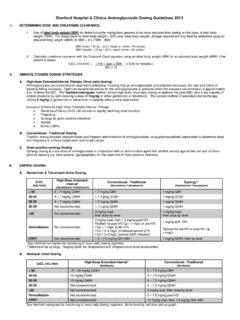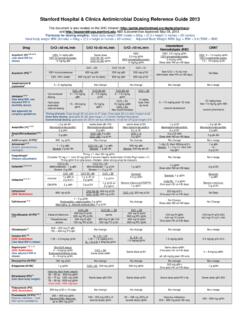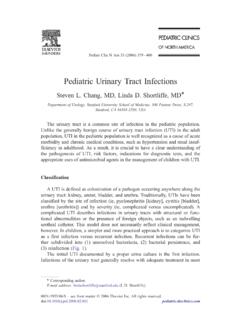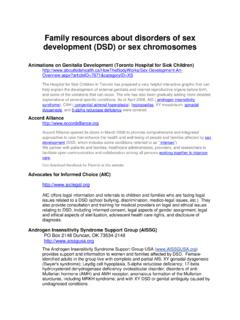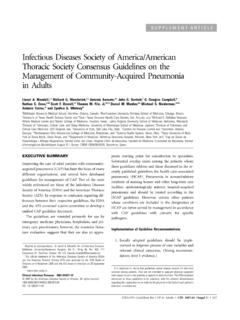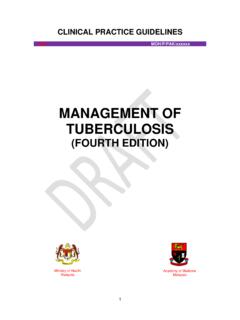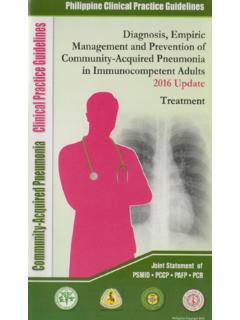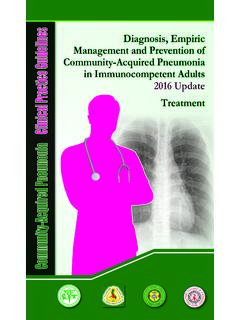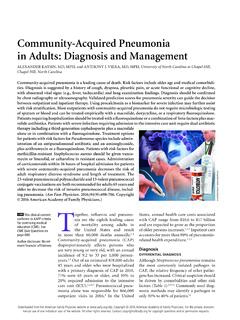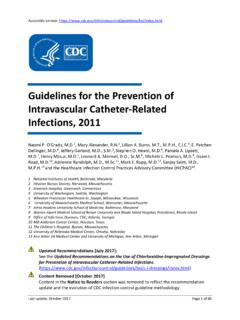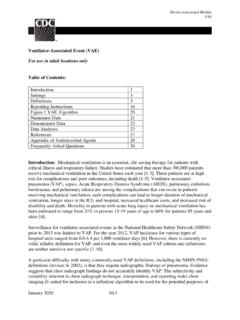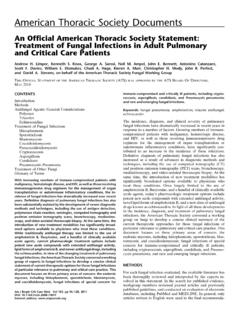Transcription of SHC Surgical Antimicrobial Prophylaxis Guidelines
1 Stanford Antimicrobial Safety and Sustainability Program Revision date 10/31/2019 SHC Surgical Antimicrobial Prophylaxis Guidelines I. Purpose/Background This document is based upon the 2013 consensus Guidelines from american society of Health-System Pharmacists (ASHP), the Infectious Diseases society of america (IDSA), the Surgical Infection society (SIS) and the society for Healthcare Epidemiology of america (SHEA) (1). The Stanford Antimicrobial Safety and Sustainability Program, in conjunction with the anesthesiology and Surgical departments, adapted its content to SHC as part of the 2015 SSI Taskforce. 1. Choice of antibiotics: Please see table I for acceptable choices of antibiotics based upon Surgical procedure. Consider the addition of vancomycin or clindamycin for patients known to be colonized with MRSA. 2. Dose of antibiotics: Please see Table II for dosing and re-dosing Guidelines .
2 We recommend weight-based dosing of both cefazolin and vancomycin. Cefazolin should be administered every 4 hours; clindamycin every 8 hours; vancomycin does not require re-dosing given its long half-life. We recommend clinicians consider re-dosing earlier than specified in Table II if there is excessive intra-operative blood loss ( >1500 mL). Aminoglycosides and vancomycin should not be re-dosed in this setting. 3. Timing of the pre-operative antibiotic dose: Guidelines recommend that pre-operative antibiotics be administered <60 minutes prior to incision. The Guidelines have not narrowed the window for pre-operative antibiotics despite acknowledging that recent data supports that antibiotics administered <30 minutes prior to incision may be more efficacious than those administered >60 minutes. Pre-operative antibiotics should reach acceptable tissue concentrations prior to the incision time in order to be effective.
3 Cefazolin (2 grams) given 30 minutes prior to incision exceeds the minimum concentration needed; however data is lacking regarding the window between 1-30 minutes. (2) Thus, we recommend that the optimal window for pre-operative antibiotics is ~15 45 minutes prior to incision. Because vancomycin and fluoroquinolones require a prolonged infusion time to avoid intolerance, especially at higher doses, Guidelines recommend that vancomycin infusion may begin 60-120 minutes prior to incision (it s long half-life makes this acceptable.) 4. Duration of post-operative antibiotics: We recommend that all patients receive <24 hours of post-operative antibiotics. In many procedures, no doses after incision closure are necessary. Refer to solid organ transplant protocols if applicable. Table I. Preferred Empiric Agent by Surgical Type.
4 (1) Preferred Agent Beta-lactam allergy Cardiac Surgery/ Vascular/Thoracic Cefazolin VancomycinP1 Cardiac Surgery with prosthetic material Cefazolin + vancomycin VancomycinP1 Cardiac device insertion ( , pacemaker implantation) Cefazolin VancomycinP1 Gastroduodenal Cefazolin VancomycinP1P + gentamicin Biliary Tract Cefazolin Metronidazole + LevofloxacinS Colorectal, appendectomy Cefazolin + metronidazole Metronidazole + LevofloxacinS Stanford Antimicrobial Safety and Sustainability Program Revision date 10/31/2019 Preferred Agent Beta-lactam allergy Other general surgery ( hernia repair, breast) Cefazolin VancomycinP1 Cesarean delivery Cefazolin ClindamycinP1P + gentamicin Gynecological (eg hysterectomy) Cefazolin ClindamycinP1P + gentamicin Head & Neck UClean (incision through skin)U: Cefazolin UClean-contaminatedU: Ear/sinonasal procedure: Cefazolin Procedures w/ oral mucosa breach: Cefazolin + Metronidazole UContaminatedU: Cefazolin + metronidazole Clindamycin Neurosurgery Cefazolin VancomycinP1 Orthopedics Cefazolin VancomycinP1 Plastic Surgery Cefazolin VancomycinP1 UrologyP2 These are empiric recommendations when no pre-op urine culture data is available or cultures were negative.
5 Cefazolin UOpen/laparoscopic involving intestineU (clean-contaminated, , radical cystectomy with ileal conduit): Cefoxitin If prosthetic material involved in urologic procedures, should add one-time dose of gentamicin GentamicinP2aP + ClindamycinP2bP UOpen/laproscopic (clean:skin incision, does not involve GU tract): ClindamycinP2b UOpen/laparoscopic involving intestine U(clean-contaminated, , radical cystectomy with ileal conduit) Metronidazole + Levofloxacin If prosthetic material involved in urologic procedures, should add one-time dose of gentamicin if not already given Heart Transplant Vancomycin + cefazolinP4 Vancomycin + levofloxacinP4 Lung or Heart-Lung Transplant Vancomycin + cefepimeP4 Vancomycin + aztreonamP4 Liver Transplant Piperacillin/tazobactamP4 VancomycinP1P or clindamycin + ciprofloxacinP4 Notes: 1.
6 Clindamycin can be used as an alternative to vancomycin. Clindamycin and vancomycin are recommended alternative agents to cefazolin for patients with beta-lactam allergies. According to our 2018 hospital-wide antibiogram (31 TUlinkU31T), 79% of MSSA isolates were susceptible to clindamycin, while 100% were susceptible to vancomycin. If practical, we recommend vancomycin as the preferred choice for those with beta-lactam allergies. 2. Urology notes Stanford Antimicrobial Safety and Sustainability Program Revision date 10/31/2019 PaP Ciprofloxacin is a reasonable alternative. However, according to the 2018 SHC antibiogram (31 Tlink31T), more E. coli isolates were susceptible to aminoglycosides than fluoroquinolones PbP If significant concern for MRSA, vancomycin should be considered as an alternative to clindamycin. According to our 2018 hospital wide antibiogram, only 55% of MRSA isolates are susceptible to clindamycin, while 100% were susceptible to vancomycin.
7 In addition, clindamycin has limited urinary penetration. However, vancomycin infusion should be started 60-120 minutes prior to incision to allow for complete drug administration. (see Table 2) 3. If cultures will be obtained intra-operatively, prophylactic antibiotics should be withheld. 4. In patients with documented infections prior to surgery, Prophylaxis should be directed at causative pathogens; consult ID. Table II: Dosing and re-dosing of Antimicrobial agents.(1) Antimicrobial Recommended Dose Re-dosing (hours) Notes Commonly used Cefazolin 2 grams > 120 kg = 3 grams 4 Clindamycin 900 mg 6 Vancomycin < 80 kg = 1 gram 80 99 kg = grams 100 -120 kg = grams >120 kg = 2 grams 12 Requires prolonged infusion time, can be given 60-120 minutes prior to incision Other Ampicillin-sulbactam 3 grams 2 Aztreonam 2 grams 4 Cefepime 2 grams 4 Renal insufficiency: contact OR pharmacy Cefotetan 2 grams 6 Cefoxitin 2 grams 2 Ceftriaxone 2 grams N/A Cefuroxime grams 4 Ciprofloxacin 400 mg 8 Requires prolonged infusion time, can be given 60-120 minutes prior to incision Ertapenem 1 gram N/A Gentamicin 5 mg/kg (single dose) If CrCl <20, 2mg/kg (single dose) or consult pharmacy N/A Stanford Antimicrobial Safety and Sustainability Program Revision date 10/31/2019 Levofloxacin 500 mg.
8 750mg if lung transplant N/A Requires prolonged infusion time, can be given 60-120 minutes prior to incision Metronidazole 500 mg 12 Piperacillin-tazobactam grams 2 Renal insufficiency: contact OR pharmacy Tobramycin 5 mg/kg (single dose) If CrCl <20, 2mg/kg (single dose) or consult pharmacy N/A Stanford Antimicrobial Safety and Sustainability Program Revision date 10/31/2019 Table III: Post-op dosing Antimicrobial Recommended Dose (Many procedures require no post-op doses of antimicrobials. If desired, limit duration to <24 hours post closure.) Refer to solid organ transplant protocols if applicable. Cefazolin 2 grams q8h up to 2 doses or see Transplant Protocols if applicable Clindamycin 900 mg q8h up to 2 doses Vancomycin 1 grams q12h up to 1 dose or see Transplant Protocols if applicable Ampicillin-sulbactam 3 grams q6h up to 3 doses Aztreonam 2 grams q8h up to 2 doses Cefepime Lung transplant.
9 2g q8h extended infusion (see Transplant Manual for duration) Cefotetan 2 grams q12h up to 1 dose Cefoxitin 2 grams q6h up to 3 doses Ceftriaxone No post-op doses needed (q24h hour dosing) Cefuroxime grams q8h up to 2 doses Ciprofloxacin 400 mg q12h up to 1 dose Gentamicin No post-op doses needed (q24h hour dosing) Levofloxacin No post-op doses needed (q24h hour dosing) Metronidazole 500 mg q8h up to 2 doses Piperacillin-tazobactam q8h extended infusion up to 2 doses or see Transplant Protocols if applicable Tobramycin No post-op doses needed (q24h hour dosing) Stanford Antimicrobial Safety and Sustainability Program Revision date 10/31/2019 II. References: 1. Bratzler DW, Dellinger EP, Olsen KM, Perl TM, Auwaerter PG, Bolon MK, et al. Clinical practice Guidelines for Antimicrobial Prophylaxis in surgery. Am J Heal Pharm.
10 2013;70(3):195 283. 2. Douglas A, Udy A a., Wallis SC, Jarrett P, Stuart J, Lassig-Smith M, et al. Plasma and tissue pharmacokinetics of cefazolin in patients undergoing elective and semielective abdominal aortic aneurysm open repair surgery. Antimicrob Agents Chemother. 2011;55(11):5238 42. 3. Abbo LM and Grossi PA, Surgical site infections: Guidelines from the american society of Transplantation Infectious Diseases Community of Practice, Clin Transplant. 2019 Sep;33(9):e13589. doi: Epub 2019 May 23. III. Document Information: A. Original Author/Date: Marisa Holubar MD MS, Emily Mui PharmD, Stan Deresinski MD, Lina Meng PharmD, Lucy Tompkins MD PhD 6/2/2016 B. Gatekeeper: Antimicrobial Stewardship Program C. Review and Renewal Requirement This document will be reviewed every three years and as required by change of law or practice D.
